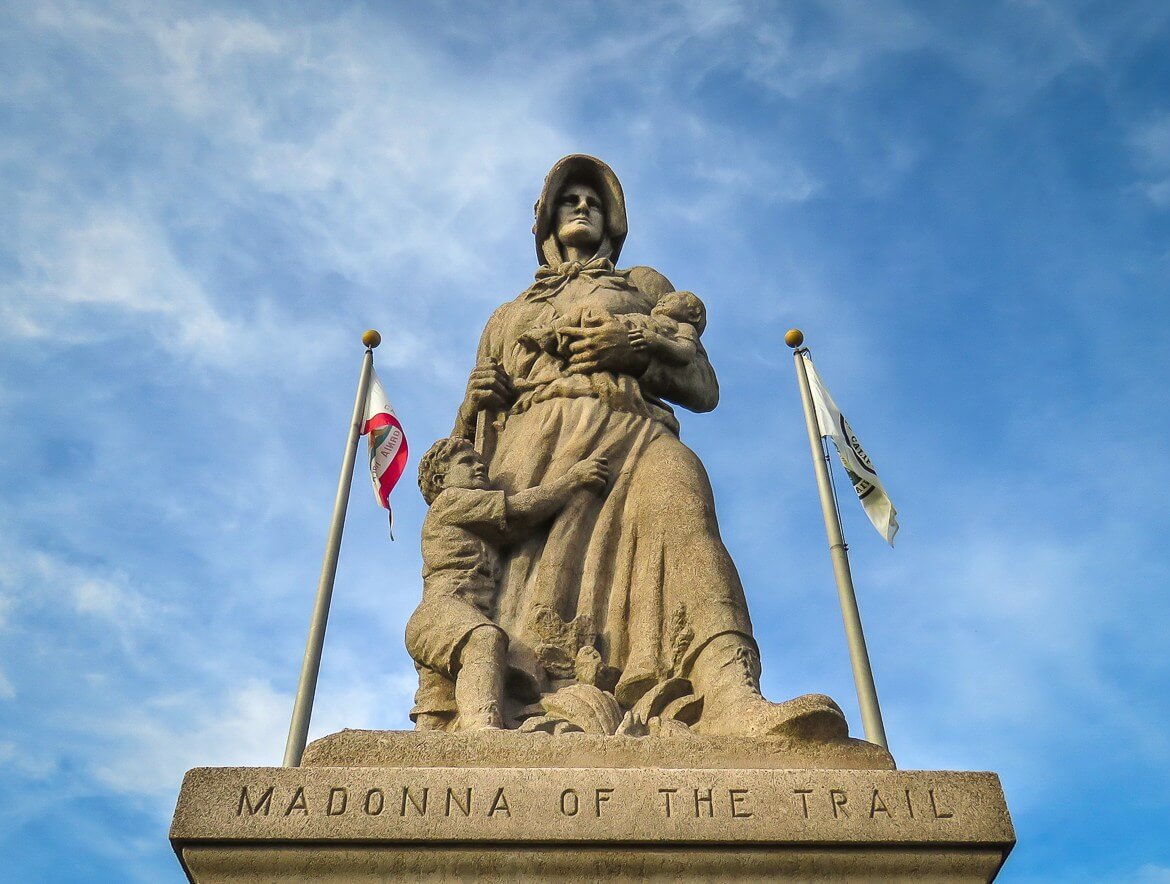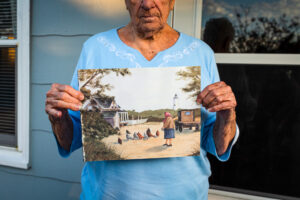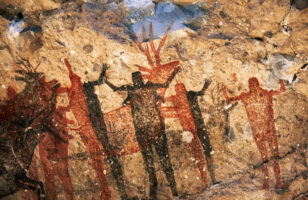Support Hidden Compass
We stand for journalism, science, history, and hope. Make a contribution to Hidden Compass and stand with us.
Istood in my Upland, California home with a dress in my hands, falling in love with its bright splashes of immense orange flowers, puffed sleeves, and princess seams that gave it a fitted, tailored look. It was the 1970s and a neighbor had brought the dress to our house. She was amused by the vintage ensembles I often wore and thought I might be interested. I was. But it wasn’t about the dress. It was about the treasure underneath it. The dress was merely a dust jacket for a custom, full-length, black silk coat. The coat had a stiff raised collar and comely points at the wrist. It was lined in soft, ivory satin. I’d never seen anything so grand.
“I haven’t wanted to give my ‘coming out coat’ to just anybody,” she said as she helped me with the buttons.
She’d worn it to her debutante ball in the 1940s. It had taken her 30 years to let it go and it was my love of vintage clothes that had told her I was the right person.
Half a century later, I still haven’t released it. I fear that if I do, something important will disappear.
~~
Euclid Avenue swept down the base of Mount Baldy as it crossed California’s Pomona Valley. Giant pepper trees dotted a center trail between lanes. Mom had packed us into the station wagon, and from the back seat, I looked up into swaying branches as we swung south. Then, heading east before the state prison, I watched sleepy housing tracts give way to flatlands — ranches, orchards, and farms spreading thick and green.
We arrived at an open-air market that reeked of livestock, but instead of inspecting cattle, sheep and pigs, we picked through used furniture, tools, and planters. Mom found a small coffee pot. To this day, I can smell the scent of burnt coffee that came from that stovetop percolator.
Too young to read a map, I knew we were close to home when I could look up into the stony gaze of a towering pioneer woman. A child clutched the folds of her long dress. She grasped a rifle with one hand and cradled a baby in the crook of her arm with the other. The Madonna of the Trail. Perpetually looking out across the valley, she stood as a testament to the grit of western frontier women. But her story seemed lost to me — confined to the pages of history books, encased in the stone of her body. Until I met Billie Eckhardt.

Madonna of the Trail — as seen in Upland, California — commemorates the gumption of pioneer women. PHOTO: ELAINE J. MASTERS.
Billie inherited her love of woodworking from her mother who had grown up on the windswept Wyoming plains. When Billie’s grandfather had built their house, he’d tasked his young daughter with making the kitchen cabinets: “You have a circular saw and joiner,” he’d told her, “you’ll figure it out.”
Old tin, broken chairs, and wrecked wagons shine like gold when Billie looks at them.
Woodworking became a passion that Billie’s mother passed on to her daughter. Billie began by reupholstering furniture and building items from reclaimed wood to sell at shows and craft fairs. Later, while moving from base to base with her enlisted husband, she made the most of military woodworking shops and even began teaching. It wasn’t until she returned to Laramie, though, that her penchant for “picking” — buying things for resale and re-purposing — led to opening Bent & Rusty craftsman’s co-op.
While driving across the south-eastern corner of Wyoming, I was drawn to the co-op’s wide windows stacked with antiques, vintage signs, and pottery. Like a magnet, they pulled me inside, where I found lamps dragged in from estate sales, and furniture made from the weathered slats and beams of old barns. Billie was working that day. She was tall and stalwart with coffee-colored hair, and a stack of silver bangles on one hand. Her co-op partner, Larca Wicke, was there, too.
I listened as Billie told me of navigating country roads on the lookout for listing barns, and negotiating with farmers to tear them down. Old tin, broken chairs, and wrecked wagons shine like gold when Billie looks at them.
~~
By my teens, my sister Julie and I were re-claimers of a different sort. I painted storybook characters on cushy, muslin pillows, and Julie once fashioned several of our grandmother’s doilies into a halter top. We tried to sell the items, but it was too much work for too little pay.
“You can’t sell for much.” Julie conceded. “In the end, it’s just a halter top.”
What money we did make ended up in the register at our favorite downtown thrift store. Working in parallel rows, we hunted for fitted fashions from the 1940s and ’50s. We looked for runs and frays in the fabric, holding pieces up to the light, searching folds for stains, and avoiding a musk of mothballs and cigarettes. Julie gushed over platform shoes. An old riding jacket with braided leather buttons and elbow patches went north with me to college.
The thrift shop wasn’t far from the cool, dark packing plant where years earlier, our mother would carefully select dented juice cans to sit alongside the jars of pulpy, Concord grape juice she pressed from vines along our backyard wall.
Salvaging is in Wyoming’s DNA.
A child of the Depression and the eleventh baby of Croatian immigrants, my mother escaped her chores and middling prospects in Minnesota a few years after high school. A picture of her waving excitedly from the California-bound train is long gone, as is one of my father gazing slyly at the camera as he posed in front of a car he’d restored with his brothers in Arizona. A stint digging ditches in the brutal Arizona sun convinced him to take a different path. Eventually, their paths intersected. My father received his law degree and moved with my mother to Upland, where their finances were thin but their prospects were high.
~~
Salvaging is in Wyoming’s DNA. In the 1830s, following the Lewis and Clark Expedition and before the Wyoming territory became a state, the first pioneers of the great westward migration left from places like Independence, Missouri and crossed the country on the promise of a better life. They planned to carry up to 2,000 pounds in their wagons, but quickly learned to discard anything that slowed them down — potbellied stoves, wedding dresses, children’s toys, and food were all left behind, including one instance in which nearly a ton of bacon was jettisoned. The Oregon, Mormon, and California Trails were soon littered with castoffs. But enterprising pickers collected usable pieces along the trail to resell to migrants at Wyoming’s South Pass outposts, where pioneers would again load up on provisions before crossing the Rockies.
The model for my California Madonna (and 11 others across the United States) may well have come through South Pass. Sculptor August Leimbach fashioned a story about his creation in 1928:“The pioneer mother with her children was waiting for the father at their blockhouse in the wild West, for the father did not come home as he had promised. She, believing him to be in danger, put her little child in a blanket, grasped the gun and with the boy ran out in the field to look for the father.” The statue commemorates the gumption of pioneer women — their self-sufficiency, their ingenuity.
~~
In Laramie, Billie and Larca find purpose in resurrecting the stories of their finds.“Some of these things, you’ll never see again,” Larca said. “You can lose the story if someone else picks [them].”
She and Billie have unearthed many stories.
In a house slated for demolition, they climbed over animal remains and old hospital beds, opening a closet to find boxes of letters. The writings traced the agreements that led to the founding of Wyoming’s oldest law firm, Corthell and King, which was established in 1887.
They found a Bible from 1853 with a family’s history outlined inside the cover, though they never found the family.
But they don’t just find these stories. They protect them. An 1874 wedding dress traveled from North Carolina, crossing the prairie via Iowa and Illinois before eventually coming to rest in Laramie. It was in a box belonging to the Cook family, along with handmade children’s clothes and a whalebone bustle with lace buttons. Curious shoppers asked questions while the dress hung in Bent & Rusty, but Billie and Larca weren’t an easy sell.
“If it doesn’t seem like a good fit, we pitch a huge price,” Billie told me, with a smile.
An intrigued young woman — a costume designer — returned repeatedly before Billie and Larca sent the dress and its story with her for $45.
~~
At home in California, I pick up the coat that I’ve kept for nearly 50 years. I feel the black silk and the buttery satin lining that still seems to melt between my fingers when I touch it. When I think about getting rid of it, I hear Billie’s voice:“Now is the time to do the picking and attach the story to [the] piece. If we don’t, these things will be gone within 30 years.” I think of the stories that Billie has resurrected, the stories she has protected, and the ones she has entrusted to others.
If Billie can bring back the stories of my Madonna — of the pioneers who settled the western frontier — maybe I can resurrect the stories of a different era. I’ll let go of the coat eventually, I’m sure: when I’m certain its story will live on.
Elaine J. Masters
Ever curious and hungry for adventure, Elaine Masters can't resist ducking into doorways and pulling over on the side of the road in pursuit of a story.
Never miss a story
Subscribe for new issue alerts.
By submitting this form, you consent to receive updates from Hidden Compass regarding new issues and other ongoing promotions such as workshop opportunities. Please refer to our Privacy Policy for more information.



